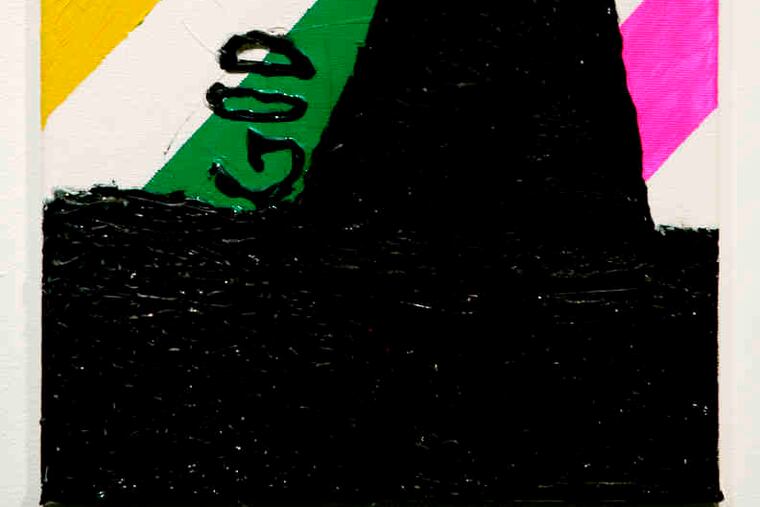Galleries: Ad-hoc artmaking by 3 Phila.-linked practitioners
Its previous long-running historical exhibition over, Fleisher/Ollman Gallery has fast-forwarded to the present with a show of new work by Lee Arnold, Sarah Gamble, and Andrew Gbur. All three artists have Philadelphia ties - Arnold and Gamble earned maste

Its previous long-running historical exhibition over, Fleisher/Ollman Gallery has fast-forwarded to the present with a show of new work by Lee Arnold, Sarah Gamble, and Andrew Gbur. All three artists have Philadelphia ties - Arnold and Gamble earned master of fine arts degrees from the University of Pennsylvania; Gbur has a bachelor of fine arts from the University of the Arts (and an M.F.A. from Yale) - and the work of all three is testament to Philadelphia's embrace of ad-hoc artmaking as practiced by Tristin Lowe, Joy Feasley, the Dufala Brothers, Isaac Lin, and Zoe Strauss, among others.
Lee Arnold's Shadows (2010) - a composition of 204 pinhole photographs (here, as digital prints) of shadows of leaves on the ground, mounted unframed in a grid composition on a wall - is a deliberately makeshift gesture, even romantic. But the grid imposes an order, and all the prints have curled at their lower right edge as if orchestrated by Arnold, giving the whole piece a uniformly rippled appearance that complements its multiple shadow images.
Two other pieces by Arnold - a grid of color Polaroid images of the ocean shot from Governor's Island in New York Harbor, and a grid of colored-pencil drawings of maritime flags arranged to spell the final words of Wittgenstein's Tractatus Logico-Philosophicus ("Whereof one cannot speak, thereof one must be silent" - are romantic in a similarly coded fashion.
The ad hoc in Sarah Gamble's paintings consists of the images of objects, architecture, and the occasional figure she cobbles together in oil on panel or mixed media on paper. In some of her recent paintings, such as Magic Brain (2010), the images - in this case, a brain in a landscape, glowing like a UFO - seem constructed from paint, while in others, they're rendered illustrationally in a spidery hand.
A filmlike grid presentation of 24 of Gamble's paintings on paper in the small gallery echoes Arnold's grids in the other room and hints at a sinister nighttime narrative.
Andrew Gbur's paintings on masking tape, on grip tape mounted to canvas, and on plain canvas are the most DIY works of this show, as well as being the most materially inventive of them. His large yellow painting on the floor, Studio Pond #2 (Process Yellow) (2010), which is the shape and size of his studio, is constructed from duct tape that Gbur laid out on the floor and painted with yellow screen-printing ink, through which the silver of the tape can be seen. Its edges are framed by sparkly grip tape, usually used on roads for its reflective quality.
Except for small photographic images in the center of each one, two large paintings on the wall look like formal abstract paintings on canvas. Then you move closer and see that he has painted on grip tape and that the paint looks matte because it's gouache. The images, both of a woman offering something with her hands, are digital prints glued to the canvas. Gbur's smaller works on canvas, depicting black, squiggly, unidentifiable forms against diagonal stripes of color (and using screen-printing ink, acrylic paint, and block-printing ink) look like - and may well be - experiments. Whatever they are, though, they're funny, and deliberately uningratiating.
What Nina says
When asked to propose an exhibition for Vox Populi, the Los Angeles-based artist and writer Malik Gaines was writing about Nina Simone, and it was the singer's "deeply invested ambivalence" and her song "Four Women" that got him thinking. "Quadruple Consciousness" is the result, and Simone's ambivalence and her uncompromising nature resonate clearly in the works of the 19 artists selected by Gaines. You never forget that this show is about identity and being truthful to that identity.
The most eloquently Simone-like pieces in this exhibition include Adam Pendleton's text Black Dada (2008-2010) and sculpture Untitled (small black cubes) (2007-
present); Zackary Drucker's video Lost Lake (2010), starring himself as a violent transgendered person; Vishal Jugdeo's alarmingly weird video Violent Broadcast (2010); Taisha Paggett's wall drawing Decomposition of a Continuous Whole, made as a performance during the show's opening; Sherin Guirguis' painted plywood sculpture Mashrabeya (2009), shaped like a cloud of smoke and cut in Islamic patterns; and Kianja Strobert's sculpture of painted concrete pavers Color Line (2010).
The gallery is hosting performances by Alexandro Segade and Adam Pendleton at 8 p.m. Jan. 29.